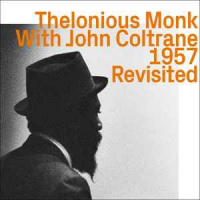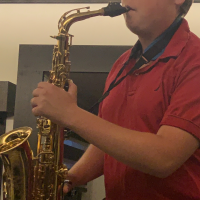Home » Jazz Musicians » Coleman Hawkins
Coleman Hawkins
Coleman Hawkins single-handedly brought the saxophone to the prominence in jazz that the instrument enjoys. Before he hit the scene, jazz groups had little use for the instrument. One player (forgot who) said, "with all due respect to Adolph Sax, Coleman Hawkins invented the saxophone." Hawkins, or "Bean", as he was known as, started playing cello at a young age before switching to the saxophone. He was a lifelong listener of classical music, and as a result, his knowledge of music theory was far ahead of his peers. Whereas Louis Armstrong improvised his solos based on the melody, Hawkins based his on the harmony and had a strong sense of rhythm.
Hawkins hit New York at the age of 20 and quickly established himself, as he became the star of the Fletcher Henderson band. His mature style (both fast and slow) emerged in 1929, and Hawkins has been credited by some to have invented the Jazz ballad. He left Henderson's band in 1934 and headed for Europe. He returned in 1939 and recorded his commercial and artistic masterpiece Body and Soul, and established himself, once again, as one of the pre-eminent soloist. The song features one of the greatest saxophone solos ever and is the standard by which all other jazz ballads are measured.
He fronted his own big band until 1941, and then went back to the New York clubs and the small group surroundings. When bebop hit the scene in the early 40s, Hawkins was one of its early supporters and in 1944, he led the first bebop recording, featuring Dizzy Gillespie and Max Roach. Bebop upset many older musicians, but Hawkins was sympathetic because he understood it. He hired young sidemen, such as Fats Navarro, Thelonious Monk, and Howard McGhee, which further identified him with the movement. In the 1940s, he toured with Norman Granz's "Jazz at the Philharmonic" concerts, all the way into 1967. His music remained strong, as did his tone, which was also very strong and large. A young tenor sax player complained once to another tenor player (in the 1950s, when Hawkins was around 50 years old) that playing next to Coleman Hawkins frightened him. The other player responded with, "Coleman Hawkins is supposed to frighten you."
Toward the end of his life, he neglected his health and drank much more. This robbed him of his "wind", and he couldn't play the long, flowing solos that he had established earlier in his life, but he could still summon up the magic.
Read moreTags
Thelonious Monk, John Coltrane: Thelonious Monk with John Coltrane 1957. Revisited.

by Stefano Merighi
Ci sono sodalizi artistici che segnano in maniera indelebile la ricchezza creativa dei protagonisti. Tra questi, di sicuro quello tra Thelonious Monk e John Coltrane, anno di grazia 1957. L'estroso pianista e compositore, ancora lontano dal ricevere i riconoscimenti meritati, trova finalmente qualcuno che interpreta le sue partiture con rara dialettica esecutiva: leggerezza e profondità, acume sottile e abbandono istintivo. L'apollineo sassofonista, all'epoca ancora turbato dalla tossicodipendenza, passa dalla frustrazione di un licenziamento da parte di ...
Continue ReadingThelonious Monk: With John Coltrane 1957 Revisited

by Chris May
Once again, the ezz-thetics label has taken some of the finest artefacts of mid-twentieth-century US jazz and sonically restored them, bringing an unprecedented level of clarity, precision and presence. It is no exaggeration to say that the Swiss-based label's work can be compared with the restoration of Michelangelo's frescoes on the ceiling of the Sistine Chapel during the 1980s, both in terms of the quality of the original material and the artistry with which the renovation has been executed. The ...
Continue ReadingA Birthday for "Bean" plus the new Matthew Shipp, William Parker, Whitt Dickey trio release

by David Brown
A time-traveling birthday tribute to the father of the tenor saxophone, Coleman “Bean" Hawkins. Plus, we visit the new release Village Mothership from the profoundly creative trio of Whit Dickey, William Parker and Matthew Shipp, and more new releases and acquisitions. Playlist Petter Eldh “Kali Koma" from Koma Saxo (We Jazz Records) 00:00Matthew Shipp Trio “Circular Temple #2 (Monk's Nightmare)" from Circular Temple (Quinton Records) 02:30 Whit Dickey, William Parker, Matthew Shipp “Whirling in the Void" from Village ...
Continue ReadingThe Sound I Saw

by Douglas Groothuis
This article was co-written with Joshua Bleeker. The Sound I Saw Roy DeCarava 208 pages ISBN: # 13: 978-1644230107 David Zwirner Books 2019 When two or more art forms combine, they may serve and harmonize and support each other or they may clash. The sound I saw combines felicitously three art forms: jazz, photography, and poetry. It is a large (10.25 x 1.2 x 13.25 ...
Continue ReadingColeman Hawkins: Fifty Years Gone, A Saxophone Across Time

by Arthur R George
Fifty years ago this past year, Coleman Hawkins, considered the father of tenor saxophone in jazz, passed away. Thelonious Monk was pacing back and forth in the hallway outside Hawkins' hospital room when the saxophonist succumbed at age 64 on the morning of May 19, 1969, from pneumonia and other complications. Monk was holding a short stack of albums that Hawkins had gifted him just before being hospitalized. With Monk was the Baroness Pannonica de Koenigswarter, attendant to ...
Continue ReadingColeman Hawkins, Oscar Pettiford and More

by Joe Dimino
This week we start with veteran Toronto jazz sax cat Joey Berkley and then move to legends like Sonny Rollins, Coleman Hawkins, Clifford Brown and Louis Armstrong. We also profile new work by Dave Bass, Gretje Angell, Miguel Zenón and Roberto Magris. From there, we hear some Twin Peaks music from Johnny Jewel and wrap it all up with the great Oscar Pettiford. Playlist Joey Berkley Band “Loss and Found" Moving Forward (Independent) 00:00 Host talks 7:00 Sonny ...
Continue ReadingThe Ascent of the Tenor - Coleman Hawkins (1929 - 1939)

by Russell Perry
The clarinet dominated the reeds throughout the 1920s. Sidney Bechet made a stand with the soprano sax and Frankie Trumbauer celebrated the lightness of the C-melody sax. And then there was Coleman Hawkins. Our guest in this hour is Jeff Decker—saxophonist, composer, educator and member of the jazz performance faculty of the University of Virginia— McIntyre School of Music. Playlist Host Intro 0:00 McKinney's Cotton Pickers “Wherever There's a Will" from Put It There (Frog) 3:03 ...
Continue ReadingColeman Hawkins Meets the Big Sax Section

Source:
JazzWax by Marc Myers
An interesting Coleman Hawkins album that's unavailable and virtually unknown today is Coleman Hawkins Meets the Big Sax Section. Originally entitled The Saxophone Section, Featuring Coleman Hawkins, it was recorded in April 1958 for the World Wide label. When Savoy re-issued the album, the label changed the title. The LP featured 4/5 of Count Basie's sax section plus pianist Nat Pierce (one of the best Basie imitators), Basie's guitarist Freddie Green, Basie's bassist Eddy Jones, and drummer Bobby Donaldson. who ...
read more
Backgrounder: Coleman Hawkins 'Desafinado' 1962

Source:
JazzWax by Marc Myers
Over two days In September 1962, Impulse producer Bob Thiele brought Coleman Hawkins into Rudy Van Gelder's recording studio in Englewood Cliffs, N.J., for a bossa nova session. By then, Paul Winter, Stan Getz, Zoot Sims and Herbie Mann, among others, had recorded albums using the new Brazilian rhythm. The key question was whether the old-school Hawkins would grasp how to play the light, hip new sound. Thiele was convinced he would, and he was right. Hawkins had set the ...
read more
Jazz Musician of the Day: Coleman Hawkins

Source:
Michael Ricci
All About Jazz is celebrating Coleman Hawkins' birthday today!
Coleman Hawkins single-handedly brought the saxophone to the prominence in jazz that the instrument enjoys. Before he hit the scene, jazz groups had little use for the instrument. One player (forgot who) said, “with all due respect to Adolph Sax, Coleman Hawkins invented the saxophone." Hawkins, or “Bean", as he was known as, started playing cello at a young age before switching to the saxophone. He was a lifelong listener of ...
read more
Hawk at the Metropol in Oslo, 1963

Source:
JazzWax by Marc Myers
On January 26, 1963, Coleman Hawkins arrived in Norway on a Scandinavian tour. He had first visited Norway, Sweden and Denmark in the mid-1930s when he was met by huge crowds. In 1963, he was in Norway to play two concerts celebrating the 10-year anniversary of Oslo's Big Chief Jazz Club. The nightclub was founded by Eivind Solberg, a New Orleans-style trumpeter who started the Big Chief Jazz Band in 1951. He had been friends with Louis Armstrong and operated ...
read more
Coleman Hawkins on Video

Source:
JazzWax by Marc Myers
Yesterday, I spent a chunk of the day listening to tenor saxophonist Coleman Hawkins while writing. Hawkins, or Hawk, remains a marvel. The first modern tenor saxophonist, Hawk could blow hot and soft, and had more to do with the invention of bebop than he's been given credit for. He was formidable his entire career, which spanned a good chunk of jazz history. His first recording was in 1921 and his last was in 1968. He died in 1969. But ...
read more
Jazz Musician of the Day: Coleman Hawkins

Source:
Michael Ricci
All About Jazz is celebrating Coleman Hawkins' birthday today!
Coleman Hawkins single-handedly brought the saxophone to the prominence in jazz that the instrument enjoys. Before he hit the scene, jazz groups had little use for the instrument. One player (forgot who) said, “with all due respect to Adolph Sax, Coleman Hawkins invented the saxophone." Hawkins, or “Bean", as he was known as, started playing cello at a young age before switching to the saxophone. He was a lifelong listener of ...
read more
Jazz Musician of the Day: Coleman Hawkins

Source:
Michael Ricci
All About Jazz is celebrating Coleman Hawkins' birthday today!
Coleman Hawkins single-handedly brought the saxophone to the prominence in jazz that the instrument enjoys. Before he hit the scene, jazz groups had little use for the instrument. One player (forgot who) said, “with all due respect to Adolph Sax, Coleman Hawkins invented the saxophone." Hawkins, or “Bean", as he was known as, started playing cello at a young age before switching to the saxophone. He was a lifelong listener of ...
read more
Jazz Musician of the Day: Coleman Hawkins

Source:
Michael Ricci
All About Jazz is celebrating Coleman Hawkins' birthday today!
Coleman Hawkins single-handedly brought the saxophone to the prominence in jazz that the instrument enjoys. Before he hit the scene, jazz groups had little use for the instrument. One player (forgot who) said, “with all due respect to Adolph Sax, Coleman Hawkins invented the saxophone." Hawkins, or “Bean", as he was known as, started playing cello at a young age before switching to the saxophone... Read more.
Place our Musician of ...
read more
Jazz Musician of the Day: Coleman Hawkins

Source:
Michael Ricci
All About Jazz is celebrating Coleman Hawkins' birthday today!
Coleman Hawkins single-handedly brought the saxophone to the prominence in jazz that the instrument enjoys. Before he hit the scene, jazz groups had little use for the instrument. One player (forgot who) said, “with all due respect to Adolph Sax, Coleman Hawkins invented the saxophone." Hawkins, or “Bean", as he was known as, started playing cello at a young age before switching to the saxophone... Read more.
Place our Musician of ...
read more
Jazz Musician of the Day: Coleman Hawkins

Source:
Michael Ricci
All About Jazz is celebrating Coleman Hawkins' birthday today!
Coleman Hawkins single-handedly brought the saxophone to the prominence in jazz that the instrument enjoys. Before he hit the scene, jazz groups had little use for the instrument. One player (forgot who) said, “with all due respect to Adolph Sax, Coleman Hawkins invented the saxophone." Hawkins, or “Bean", as he was known as, started playing cello at a young age before switching to the saxophone... Read more.
Place our Musician of ...
read more
































































